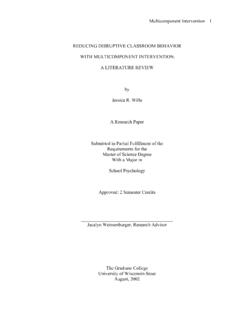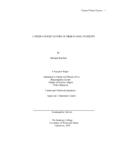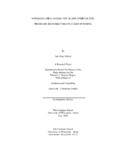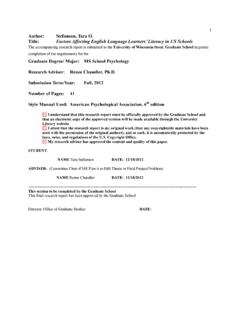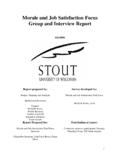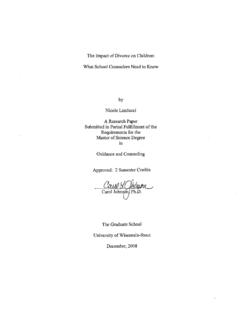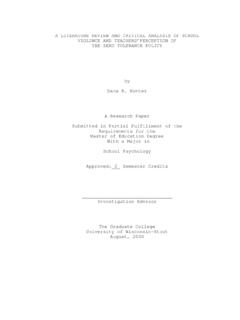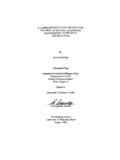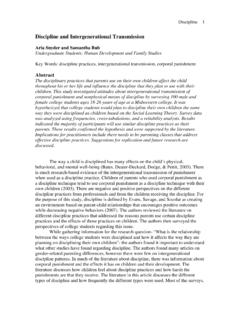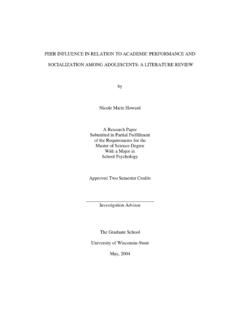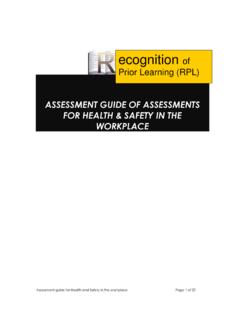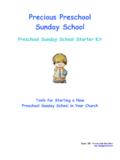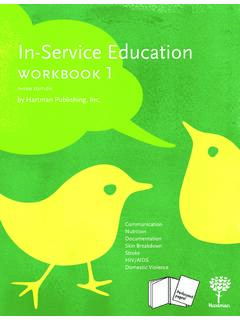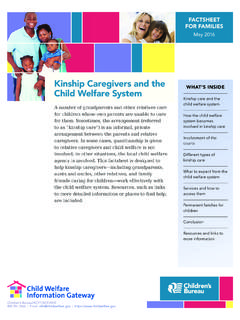Transcription of Teens and Risky Sexual Behavior - UW-Stout
1 Teens and Risky Sexual Behavior : What School Counselors Need to Know by Brittany J. Loew/Thompson A Research Paper Submitted in Partial Fulfillment of the Requirements for the Master of Science Degree III School Counseling Approved: 2 Semester Credits l The Graduate School University of Wisconsin-Stout May, 2011 Author: Title: The Graduate School University of Wisconsin-Stout Menomonie, WI Loew/Thompson, Brittany J. Teens and Risky Sexual Behavior : What School Counselors Need to Know Graduate Degree/ Major: MS School Counseling Research Adviser: Carol Johnson, MonthrYear: May, 2011 Number of Pages: 26 Style Manual Used: American Psychological Association, 6th edition Abstract 2 The literature review provides an overview of research pertaining to adolescence decision making, early Sexual activity, and other Risky behaviors. The role of parent, role of school counselor and what the school counselor needs to know is critical to providing the information Teens need to avoid making life-altering decisions.
2 Aspects of the risks of early Sexual activity and consequences are examined. Literature describing how school counselors can incorporate sex education programs is presented and insight in how to approach adolescence about early Sexual activity and how to maintain confidentiality is presented in this study. The Graduate School University of Wisconsin Stout Menomonie, WI Acknowledgments I would like to thank my family for all their support throughout my graduate school 3 training. I especially would like to thank my husband, Derek Thompson, for his love, support, and friendship throughout this journey. My thesis advisor, Carol Johnson, has helped me is so many ways. She has motivated me, reminded me to stay positive, and helped me stay focused on completing my thesis. I would also like to acknowledge the University of Wisconsin-Stout school counseling faculty and thank them also for all the knowledge, skills and experiences that contributed to my education and service to others.
3 4 Table of Contents .. Page Abstract .. 2 Chapter I: Introduction .. 5 Statement of the Problem .. 7 Purpose of the Study .. 7 Assumptions of the Study .. 8 Definition of Terms .. 8 Limitations .. 9 Chapter II: Literature Review .. 1 0 Introduction .. 10 Decision Making of Adolescence .. , .. 10 Early Sexual Activity .. 12 Risky Behavior .. 15 Role of Parent .. 17 Role of School Counselor .. 17 Chapter III: Summary, Discussion and Recommendations ..21 Introduction .. 21 Summary .. 22 Recommendations .. 23 References .. 24 5 Chapter I: Introduction Skimming though the channels on television, one may notice that the language, Sexual content and themes for programs targeting teenagers have dramatically changed over the years. Reality shows young Teens making adult decision far before they are developmentally and physically ready. Teenagers, including younger brothers and sisters, nieces, nephews, grandchildren, our own children, students, and our friends, are at risk; not only from diseases such as AIDS, STDs, and unplanned pregnancy, but also from the media's influence on progressive Sexual Behavior .
4 Teenagers are engaging in Sexual activities at younger ages each year; Sexual activities meaning Sexual intercourse, oral sex, and anal sex. With the increase in access to media by television, Internet, magazines, and music, teenagers are actively engaged by Sexual words, actions, songs, and pictures whether it is at school, at home, or in public. Not only is the media having an impact on the increase of Sexual -activity of teenagers, but the peer pressure from friends also has a major impact. According to National Center for Chronic Disease Prevention (2009), in 2007,48% of high school students had had Sexual intercourse, and 15% of high school students had had four or more sex partners thus far in their young lives and roughly 39% of currently sexually active high school students did not use a condom during their last Sexual encounter. The study also indicated that in 2002, 11 % of males and females aged 15-19 had engaged in anal sex with someone of the opposite sex and 3% of males aged 15-19 had had anal sex with a male and 55% of males and 54% of females aged 15-19 had engaged in oral sex with someone of the opposite sex.
5 In 2006, the Center for Disease Control (CDC) estimated 5,259 young people aged 13-24 in the33 states reporting to CDC were diagnosed with HIV/AIDS, representing about 14% of the 6 persons diagnosed that year. Each year, there are approximately a million new STD infections, and almost half of them are among youth aged 15-24. In 2002, 12 % of all pregnancies, or 757,000, occurred among adolescents aged 15-19. Adolescents are more likely to engage in high-risk Behavior , such as unprotected sex, when they are under the influence of drugs or alcohol (CDC, 2009). According to Teen Sexual Behavior : Issues and Concerns (2008),83% of the episodes of the top twenty shows among teen viewers contained some Sexual content, including 20% with Sexual intercourse, and 42% of the songs on the top CDs in 1999 contained Sexual content; 19% included direct descriptions of Sexual intercourse.
6 On average, music videos contain 93 Sexual situations per hour, including 11 "hard core" scenes depicting behaviors such as intercourse and oral sex. Girls who watched more than fourteen hours of rap music videos per week were more likely to have multiple sex partners, and to be diagnosed with a sexually transmitted disease. Before parents raised an outcry, Abercrombie and Fitch marketed a line of thong underpants decorated with sexually provocative phrases such as "Wink Wink" and "Eye Candy" to ten year olds. Neilson estimates that million children ages 2-11 and million Teens ages 12-17 watched Justin Timberlake rip open Janet Jackson's bodice during the 2004 Super Bowl halftime show (Focus Adults Surveys, 2008). The number of teenagers involved in Risky Sexual Behavior is increasing in epidemic proportions. This could be in part because Teens have misconceptions about sex and its consequences.
7 Some misconceptions might include that "all Teens are having sex," and" you can't get pregnant your first time having sex," or "oral or anal sex are not really sex." To make matters worse, parents are often uninformed themselves regarding how to communicate with their children about sex and Risky behaviors. Adolescences are more likely to become involved 7 with Risky Sexual behaviors when their parents are uneducated, where there is minimal communication between parents and child, when they engage in non-parental supervised activities, hang around sexually active friends, earn low school grades, and not having enough activities to keep them busy. This Sexual epidemic is happening at a faster rate and it's happening in homes, schools, and communities. Until children are taught about the risks, understand the risks and responsibilities of having unprotected sex, children will continue to be in danger.
8 Statement of the Problem Teenagers are beginning to experiment with Risky Sexual Behavior at younger ages, in part due to the mass media, peer pressure, and the lack of supervision by parents and other adults. Not only are adolescences at-risk for disease or pregnancy, but they are also experimenting with drugs and alcohol, which may also lead to unplanned sex. The disturbing reality is that this is happening with increasing frequency. It is important for school counselors to be aware of the increase in promiscuity and plan to include the topic in appropriate guidance lessons that raise awareness of the consequences. Therefore, the problem becomes, What behaviors of risk are students engaging in and what do school counselors need to know about Risky Sexual Behavior of to day's Teens ? Purpose of the Study The purpose of this study is to raise awareness for caring adults and educators about the risks and consequences of involvement in Risky Sexual Behavior at a young age.
9 The review of literature was developed in the spring 2011 using media, research and professional studies to gather information on the topic of Risky Sexual Behavior of teenagers. 8 The research objectives are to determine what kinds of Behavior that adolescences are choosing that involves Risky Sexual promiscuity, and to determine strategies that school counselors and parents may wish to use to minimize student's engagements in Risky Sexual Behavior . Assumptions of the Study It was assumed that since the mass media and Internet use is growing and more widely available, and that adolescents have more access to Sexual music, videos, words promoting sex, awareness of Sexual transmitted diseases. It is also assumed that some literature may not be able to be all-encompassing with cun'ent strategies for today's teenagers. Another assumption is that schools will continue to be a source of reliable and accurate information for students regarding this topic.
10 A final assumption is that some resources may have been unavailable or overlooked due to limited time and resources by the researcher in the spring of 20 11. Definition of Terms The terms in this paper that may need clarification and a proper definition for a reader's understanding are given below. Adolescence. The period of life between childhood and maturity. Adolescent. Somebody who has reached puberty, but is not yet an adult. AIDS. A disease of the immune system caused by infection with the retrovirus HIV, which destroys some types of white blood cells and is transmitted through blood or bodily secretions such as semen. Patients lose the ability to fight infections, often dying from secondary causes such as pneumonia or Kaposi's sarcoma. 9 Haley Effect. When teenagers are mulling over a question of right or wrong, safety or danger, they take into account what others do or think.
